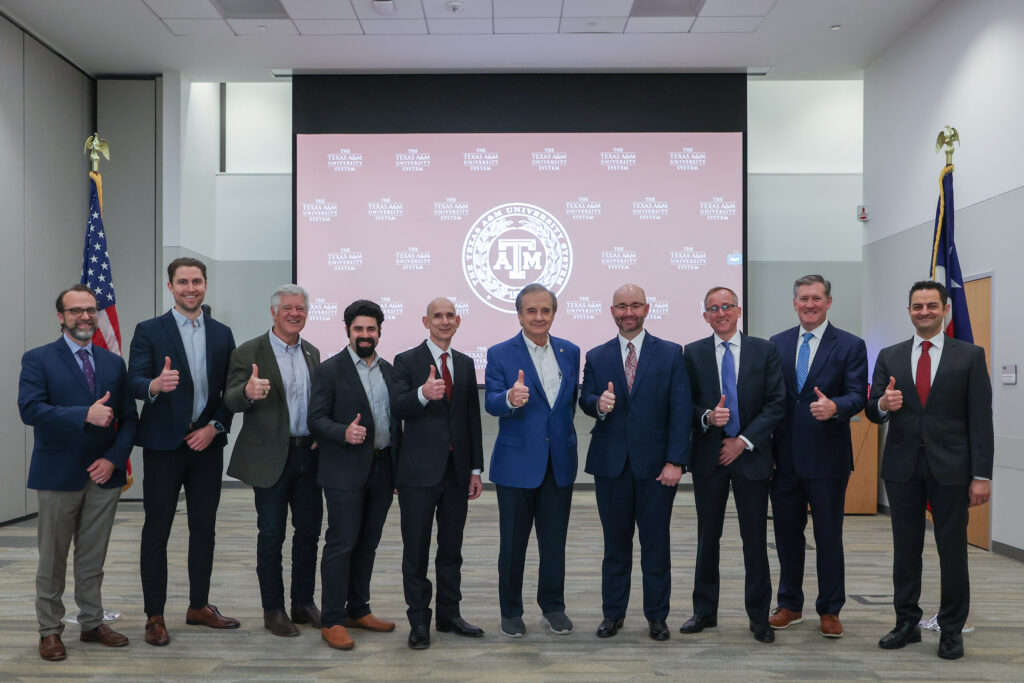Texas A&M System Goes Nuclear

Four Advanced Reactor Companies Could Fastrack Deployment of Latest Nuclear Reactors on System Land

BRYAN-COLLEGE STATION, Texas — The Texas A&M University System has provided the missing element needed to bring more nuclear power to the state’s electric grid.
Chancellor John Sharp announced Tuesday he has offered land near the Texas A&M University campus to four nuclear reactor companies so they can build the latest small modular reactors, or SMRs. Until now, reactor manufacturers – along with the most powerful names in Big Tech – have not been able to find a suitable place to build clusters of nuclear reactors that can supply the power needed for artificial intelligence endeavors, data centers and other projects.
“Plain and simple: the United States needs more power,” Sharp said. “And nowhere in the country, other than Texas, is anyone willing to step up and build the power plants we need. Thanks to the leadership of Gov. Greg Abbott and others in Texas state government, Texas A&M System stands ready to step up and do what is necessary for the country to thrive.”
Chief executive officers from four nuclear companies – Kairos Power, Natura Resources, Terrestrial Energy and Aalo Atomics – all have agreed to work with the System to bring reactors to Texas A&M-RELLIS, a 2,400-acre technology and innovation campus in Bryan, Texas, as part of a project dubbed “The Energy Proving Ground.”
At the site, the companies will work toward bringing commercial-ready technologies to the System land and using the project to test the latest prototypes.
The first reactors could be constructed within five years. Once it is completed, power generated at the proving ground could supply power to the Electric Reliability Council of Texas, or ERCOT, as it is more commonly called.
Mike Laufer, co-founder and CEO of Kairos Power, said his company could bring one or more commercial deployments to the site. He added that the surging demand for clean electricity has brought nuclear energy to the forefront of the national discussion as a vital source of reliable, carbon-free energy.
“We are excited about the momentum for new nuclear deployment at Texas A&M-RELLIS and its potential to support U.S. energy security and continued economic growth. We look forward to collaborating with the Texas A&M System to advance Kairos Power’s clean energy mission and play a new role in developing the nation’s future nuclear workforce.”
Douglass Robison, the founder and CEO of Natura Resources, said that the Texas A&M System has been an integral partner over the past five years, collaborating with the company to develop the Natura MSR-1 demonstration system.
“We are thrilled to continue this partnership with the Texas A&M System to deploy our commercial system, the Natura MSR-100, on the Texas A&M-RELLIS campus,” Robison said. “We plan to showcase how our technology can address the energy needs of Texas and the nation.”
Simon Irish, CEO of Terrestrial Energy, said his hope for the partnership is to develop Integral Molten Salt Reactor, or IMSR, technology at the site in Bryan.
“Our partnership with Texas A&M at its RELLIS campus is an important strategic relationship, which showcases the commercial potential of our small modular power plant and its advanced nuclear technology,” Irish said. “Siting an IMSR plant at the RELLIS campus leverages Texas A&M’s world-class research and nuclear engineering capabilities; provides a source of clean, firm electricity for the local grid (ERCOT); and positions Texas as a leader in America’s nuclear technology sector.”
Matt Loszak, co-founder and CEO, Aalo Atomics, said his company could build up to six Aalo Pods at the site.
“We are excited to partner with an innovation leader like the Texas A&M System, and to jointly help shape the future of energy while creating opportunities for research, education, and the Texas economy,” Loszak said. “This collaboration is a pivotal step for Aalo as it provides us with a platform to demonstrate the potential of our factory mass-manufactured nuclear technology to deliver reliable, clean energy that will ultimately power the next generation of data centers and AI infrastructure.”
Texas A&M System officials have streamlined the regulatory process to allow the four companies to quickly get their reactors operational. The System already began the application process with the U.S. Nuclear Regulatory Commission for an Early Site Permit. The application will be for the potential development of commercial electrical and thermal power generation facilities. The proposed site at Texas A&M-RELLIS is projected to accommodate multiple SMRs with a combined electrical output of more than one gigawatt.
This project at Texas A&M-RELLIS is part of the Texas A&M System’s broader commitment to advancing nuclear research, education and energy production. System officials believe the Energy Proving Ground will position the Texas A&M System as a leader in sustainable, advanced energy solutions to meet the growing energy demands of the world.
Joe Elabd, vice chancellor for research at the Texas A&M System, said the Energy Proving Ground will have an extraordinary effect on the future of energy delivery in the U.S.
“The agreements that the Texas A&M System has with Kairos, Natura, Terrestrial and Aalo are going to change the energy landscape for the whole country,” Elabd said. “The Energy Proving Ground will allow these companies to safely test their SMRs and set the stage for deploying small nuclear reactors across the country.”
About The Texas A&M University System
The Texas A&M University System is one of the largest systems of higher education in the nation, with a budget of $7.3 billion. Through a statewide network of 11 universities, a comprehensive health science center, eight state agencies, Texas A&M-Fort Worth and Texas A&M-RELLIS, the Texas A&M System educates more than 157,000 students and makes more than 21 million additional educational contacts through service and outreach programs each year. System-wide, research and development expenditures exceed $1.5 billion and help drive the state’s economy.
Contact: Laylan Copelin
Vice Chancellor of Marketing and Communications
(979) 458-6425
(512) 289-2782 cell
lcopelin@tamus.edu